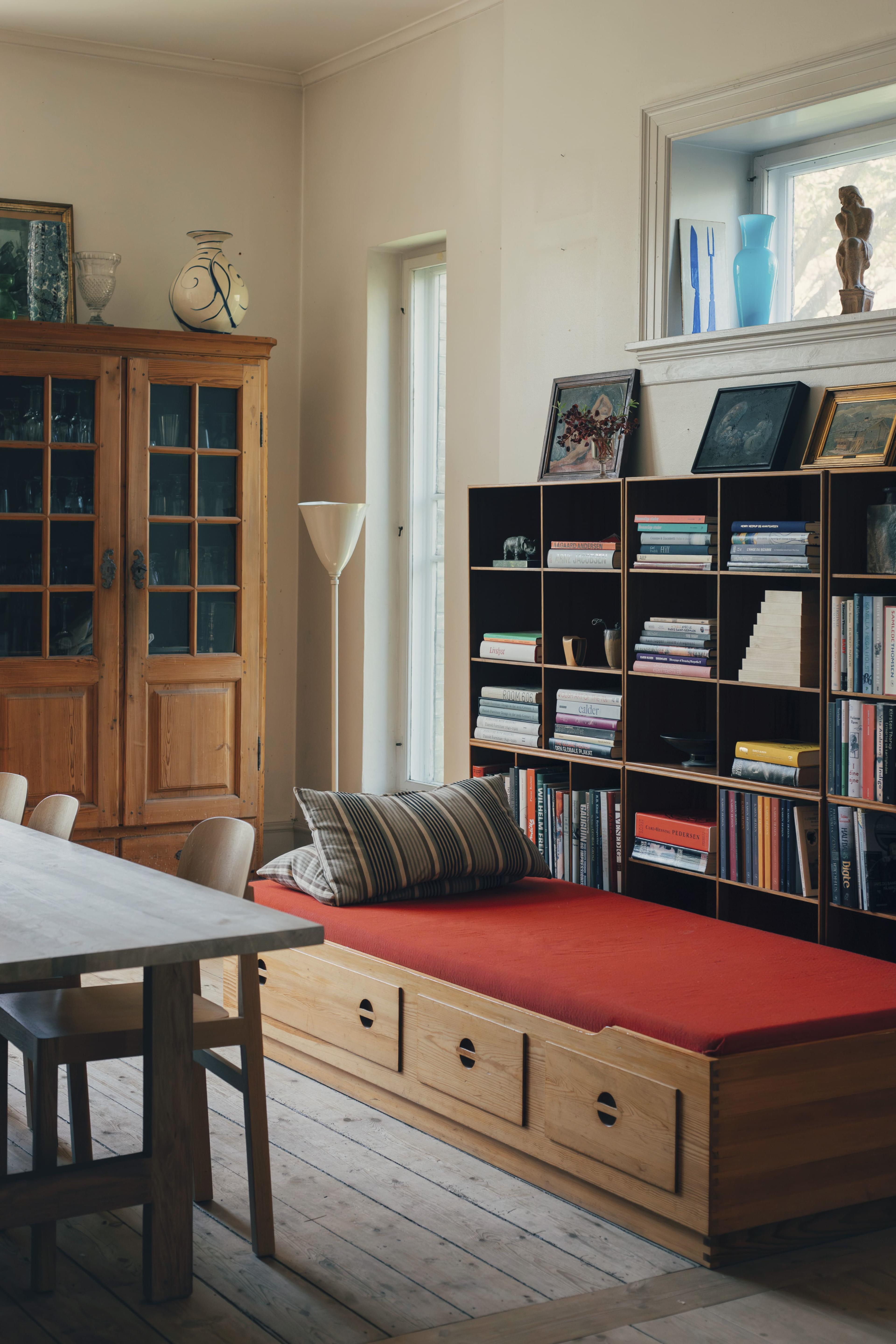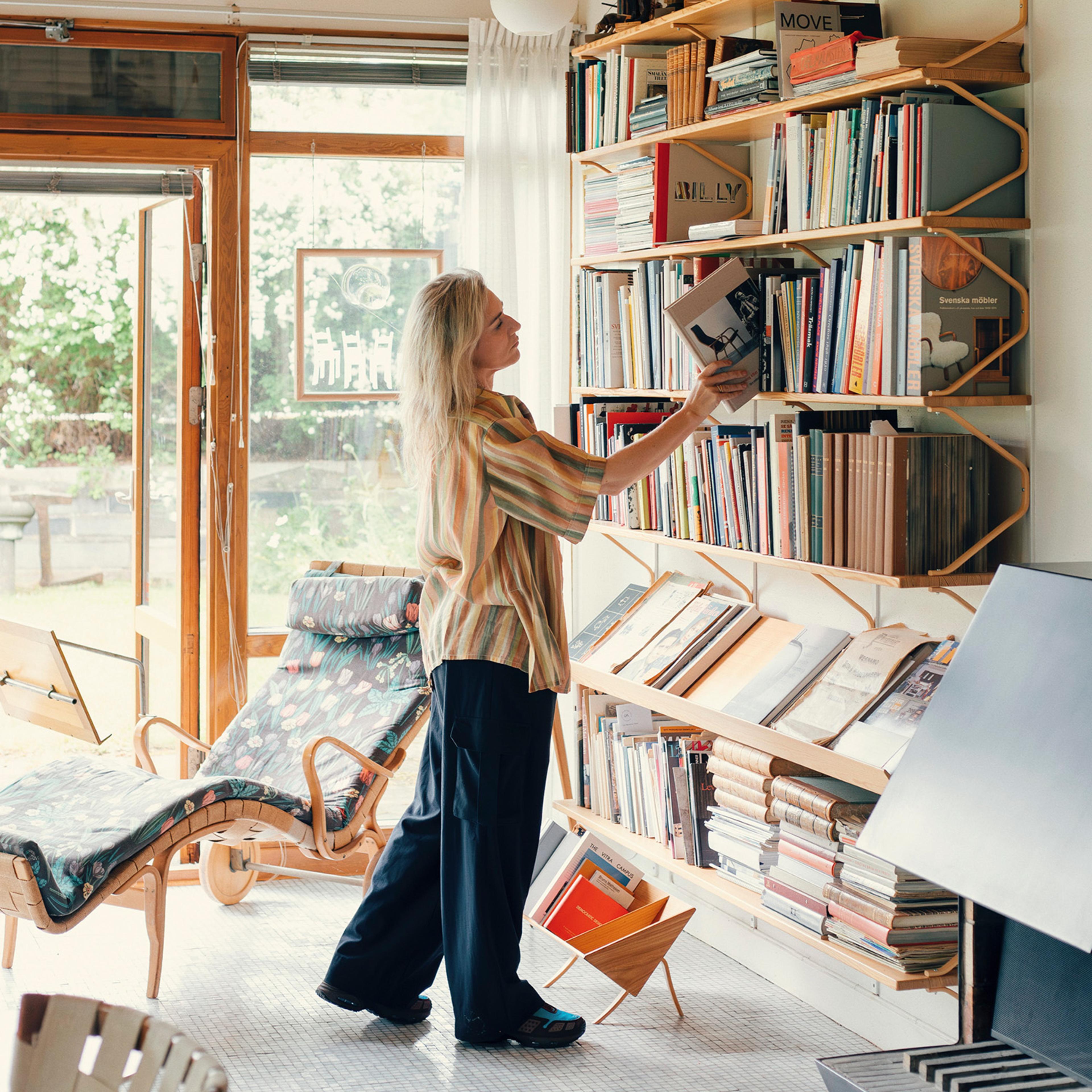Michael Bjørn Nellemann: The Last Maximalist
Michael Bjørn Nellemann reads everywhere. On the metro, in his back office and on the red benches outside his bookshop. Books, he says, are here to stay: “The feeling of paper. The typography. Silence. Concentration. No beeps to interrupt you. Just a book.”
Perhaps this is why his bookshops do not feel like stores. They are spaces for contemplation and conversation – sanctuaries within a digital world. Thiemers Magasin has become a Copenhagen institution. A hang-out for readers, collectors and coffee lovers.
We caught up with Michael Bjørn Nellemann at his new bookshop – Thiemers in the Women’s Building – and among the shelves of his private library for a conversation about literature, architecture, Danish design and what it is like to be a self-declared maximalist in a minimalist era.
Thiemers Magasin opened its doors on Tullinsgade in Copenhagen in 2013, and since then, it has been described in many ways: “Copenhagen’s Coziest Bookshop,” “The Bookshop of the Cultural Elite,” and simply “Thiemers.” If specialised book recommendations are not exactly your thing, then you can also enjoy a cup of coffee at Thiemers Coffeeshop. Each book is carefully chosen for its quality, social relevance, boldness and compelling cover art. And you will never find cocoa powder sprinkled on top of the coffee foam. Nothing is left to chance at Thiemers. It is not by chance that their newest bookshop happens to be in a very special building in central Copenhagen: The Women’s Building. Here, there is a highly curated selection of new and classic books that are largely for, by, and about women. It is a space dedicated to the advancement of equality through literature. But how do you go about designing a little bookshop with such big ambitions?


“ It means a lot to me to be part of shaping the public dialogue. Especially because I believe equality is one of the most important issues we face. The authors I read often bring these kinds of topics to the fore – and equality is definitely one of the big ones for me. ”
Michael Bjørn Nellemann, on his interests at the moment






The Women’s Building is a historically preserved building that was designed by the architect Ragna Grubb in 1935.
What considerations did you make regarding the relationship between the location and the new bookshop’s interior design?
MN: “I want all of my businesses to have an intimate quality to them. They all look different because each one is adapted to its building and purpose. When you walk into a historic place like The Women’s Building, you quickly realise how important both form and function are—and that the balance between them can shift either way. You have great creative possibilities, but you also have the possibility of ruining something precious. That’s why I joined forces with the architect Marie-Louise Høstbo, who established a clear strategy and a framework for the project.
She knows the functionalist architecture of the era when the Women’s Building was built, and her simple, thoughtful interior design fits beautifully with the building’s history and character. This is partly because Høstbo made excellent decisions and partly because she succeeded in holding her ground when I tried to nudge her with my maximalist leanings. My starting place for the bookshop’s design was a painting of a woman seen from behind, looking at a bookshelf. I think that one image shapes the whole project.
Most importantly, the bookshop is a space for people. That is the core. Perhaps it looks a bit more like a home than a shop and I’ll be glad if that’s the impression other people get too. It is thrilling when customers leave our shop feeling inspired. I hope they go back into the world with their minds a little more at ease, their appetites for life a little bigger, and yes, ideally with a bunch of books in their tote bags.”
The books in Thiemers Magasin reflect the current topics of conversation as well as the personal interests of the booksellers. What are you interested in at the moment?
MN: “I’m drawn to both the big picture and the personal—like what’s happening in geopolitics, but also questions like whether someone can stay true to themselves and steady in their love. I’m interested in questions like whether there’s still hope for the future, and if literature might hold some answers to the problems that are weighing on young people today.
It means a lot to me to be part of shaping the public dialogue. Especially because I believe equality is one of the most important issues we face. The authors I read often bring these kinds of topics to the fore—and equality is definitely one of the big ones for me.






You host regular art exhibitions at Thiemers – most recently ‘In Common’, a curated selection of works by the designers Maria Bruun and Sara Martinsen. What do art, design and literature have in common?
MN: “I think of writers and designers are related in terms of their focus on life and art. In most cases, a book is lifeblood tapped directly from an author. If it suddenly starts to sell a lot of copies, then all at once some people will see it as a commodity. But to begin with, it was a narrative, a story and a work of art, more than it was a commodity.
The same goes for good designers. When they create an object, they develop a hypothesis in order to realise some previously unknown potential. And if their work is a success, then we will come to view it as a commodity. But that’s a mistake because the concept and the story always come first.”
You have owned an auction house and you sit on the jury for the Wegner Prize. How did you first become interested in art and design?
MN: “I grew up in a home full of art and design. I’ve been visiting exhibitions and art auctions for as long as I can remember. Early on in my adulthood, I flirted with a life outside the arts but I quickly found my way back home. Since then, my life has been filled with books, art, design and music.
I tend to fall in love with art and design on the spot, and I take all sorts of stuff home that I later realise I don’t have space for and don’t really need. It used to be a bigger problem but things still go wrong sometimes. This is one of my great joys in life, though, because it means my home is in a constant state of flux. When I come across something wonderful, I’ll always be able to find space for it, whether it’s an old champagne bucket or a new piece of Danish design.
I’d like to live in an orderly home, but it’s probably a lost cause. I have lots of bookcases at home, including some by Mogens Koch that I inherited. For me, shelving is primarily a practical matter but when they’re beautifully designed and the wood is carefully selected, I can see beyond functionality. I’m very fond of my old Mogens Koch bookcases, especially as they tell their own history and now, they’re part of a new story alongside the other objects I live with.”
Personal collection and recommendations
What books do you have in your personal collection?
MN: “I have far too many art books. I’ve gotten rid of all my books a few times in my life but they always find their way back with new titles and covers. Naturally, I also have lots of novels but fortunately I also have friends and family who are willing to take them off my hands once I’ve read them.
No matter how important a book is to me, I think it ought to be circulating out in the world. I don’t need to keep the ones I’ve already read – though there are a few exceptions! It’s a wonderful thing to give someone a book and then have a conversation about it half a year later.”
“You don’t need to be lying in a hammock or out on a dock with your feet in the water to have a good reading experience,” Nellemann points out. He himself reads books everywhere. “No matter where you are, a book is going to take you somewhere else entirely,” he explains. “The feeling of paper. Mindful typography. A nicely done cover. Silence. Concentration. No Chargers. No blue light. No beeps to interrupt you. Just a book. Books are here to stay.”
Do you have any book recommendations?
1. Emma Holten’s Deficit is a sophisticated and unorthodox contribution to an important economic debate.
2. I also recommend Maj Humaidan’s Soft. She and Holten write in accessible prose and they receive both criticism and praise with admirable grace. For them, their subject is more important than their egos, and I like that.
3. Finally, Helle Helle’s writing is nothing less than dazzling. This has been the case for a long time and with every new book one worries whether they can keep on being so good. But there’s nothing to fear! It may seem impossible, but she always surpasses herself. This is also the case with her latest novel Hey Hafni.


Keep exploring
Through a series of narratives, we explore inspiring spaces, delve into architectural history topics, explore the essence of good design, and celebrate the cultivation of unique atmospheres.
1 of 5

















